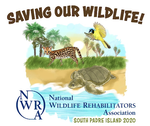General Abstracts
Watch Videos (Login required)
|
Wildlife Rehabilitation in Hawaii Patrick Hogan & Sophia Torres Hawaii Wildlife Center, HI Full Abstract
The Hawaii Wildlife Center (HWC) specializes in the rescue, response, and hospital care of Hawaii’s native birds and bats statewide, nearly 70 species/sub-species total. Patients are from the main Hawaiian Islands and HWC provides projects, training, and emergency wildlife response in the remote Pacific islands. The vision of HWC is a world where native species recover and thrive through comprehensive conservation strategies and partnerships. HWC’s mission is to protect, conserve, and aid in the recovery of Hawaii’s native wildlife through hands-on treatment, research, training, science education, and cultural programs. |
Reframing Professionalism in Wildlife Rehabilitation Jenny Schlieps Focus Wildlife, WA Full Abstract
Wildlife rehabilitation has grown into a nationally recognized professionn. Rehabilitators must meet minimum standards and often exceed them. While professionalism in rehabilitation continues to grow, the resources for enclosures, food, staff, and veterinary services still rely largely on volunteers, donations, and our own funds. The lack of an established source of funding is a limiting factor in quality of care and recruitment into the field; it also undermines animal welfare. Changing the perception of wildlife rehabilitation from a “labor of love” into a funded profession is an important conversation for the future of our field. |
Welfare in Wildlife Rehabilitation: Maintaining High Standards
in All Settings Renée Schott, DVM Wildlife Rehabilitation Center of Minnesota, MN Full Abstract
Animal welfare is an especially important consideration when rehabilitating wildlife, especially in a setting or location that has multiple purposes, such as a private practice veterinary clinic, a domestic animal shelter, or simply a part of one’s house. This interactive presentation first briefly covers the basics of animal welfare, then covers the causes of stress in captive wildlife, what we can do to mitigate those stressors, and finally the ethical implications of caring for wildlife in a rehabilitation setting. |

